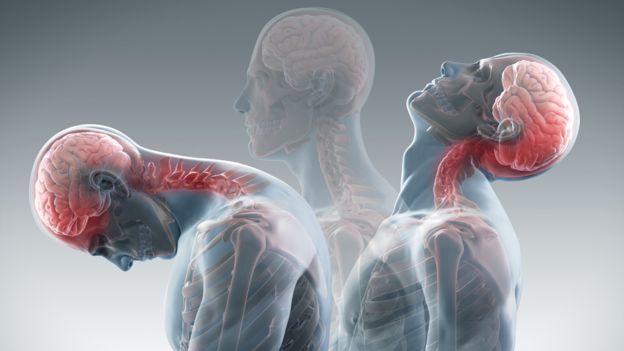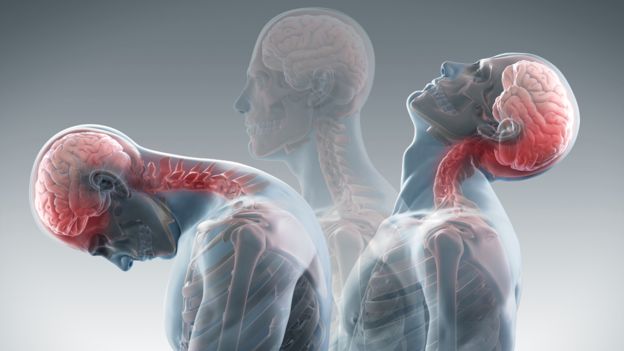Whiplash injury is a relatively common injury that can result in significant pain and a negative impact on a person's range of movement for what can be a substantial amount of time in some cases. Although many people have heard the term whiplash injury, they may not fully understand what is involved with this type of injury.
Skip to a section:
- What is whiplash
- Biomechanics of the injury
- How long it takes to recover
- Common Causes of whiplash
- Whiplash: Women vs. Men
- How would you know if it is whiplash injury (Symptoms)
- How to prevent whiplash injuries
- Treatment and recovery from whiplash injury
- Final Thoughts
What is a Whiplash Injury
A hyperextension and flexion injury to the neck, often a result of being struck from behind, as by a fast-moving vehicle in a car accident.
A whiplash injury typically occurs when a person's head is thrown backward and then forward in a particularly violent manner, according to the world-renowned Mayo Clinic. The extreme movement of the neck causes a straining of the muscles and ligaments in a person's neck.
Biomechanics of whiplash injury:
In a typical rear-end collision, the occupant’s pelvis, torso, and head are accelerated forward in rapid succession. The large inertia of the head results in a retraction of the initially stationary head relative to the forward accelerating torso and this motion induces compression, shear, and ultimately tension in the cervical spine.
How long it takes to recover from whiplash injury:
Because of the nature of whiplash injury, and the manner in which the neck functions, this type of condition can take what amounts to a significant amount of time to resolve in some cases. Indeed, neck movement can work to aggravate whiplash, lengthening the recovery time.
Most people will recover from whiplash in about two to three months. However, in some cases, recovery from this type of injury can take up to two years, according to the Mayo Clinic.
Common Causes of Whiplash Injury
Although whiplash can result from a variety of different types of events, there exist three more common causes for this kind of injury. The most common cause of whiplash injury is an automobile collision.
Whiplash Injury by auto collision

Rear-end collisions are the most common cause of whiplash. When it comes to whiplash caused by an automobile collision, the type of accident usually involves a vehicle being "rear-ended" by another car. Even a rear-end collision at a relatively low rate of speed can result in a person suffering a whiplash injury.
Whiplash by Contact sports
Another cause of whiplash injury is contact sports, particularly U.S. football. Whiplash is caused when players collide. One of the most common instances in which a football player suffers whiplash is when he is tackled by another player who comes up from behind. Football tackles and other sports-related collisions can sometimes cause whiplash injuries.
Read: Common sports injuries and prevention techniques
Physical abuse or assault
Yet another cause of whiplash results from situations in which a person is involved in an incident of physical abuse or violence. For example, a person who is punched in the face can end up not only with facial injuries but with whiplash as well. Sadly, shaken baby syndrome also results in an infant or small child sustaining whiplash.
Whiplash: Women Versus Men
Whiplash injury is more common among women than among men. The reason this is the case arises from the fact that in most cases, a woman's neck is not as strong as that of her male counterparts.
Whiplash Injury Diagnosis
The symptoms associated with whiplash injury, combined with an associated event that proceeded these symptoms, tends to make a diagnosis of whiplash somewhat straightforward. There exist a range of symptoms that commonly are associated with this type of injury.
Pain typically is the prominent symptom associated with a diagnosis of whiplash injury. In some cases, the associated pain can be quite profound, significant. The pain can be persistent or flares up when a person's neck rocks back and forth or from side to side.
A diagnosis of whiplash injury commonly is also based upon a decreased or restricted range of movement. There may also be a tightness in the neck. In addition, a person diagnosed with whiplash injury will have a feeling of knotted or hard muscles in the neck.
In making a diagnosis of whiplash, a patient will usually experience tenderness in the neck region. This includes tenderness to touch. Finally, headaches are common when it comes to making a diagnosis of a whiplash injury. The headaches radiate from the base of the skull upwards to a person's forehead.
Signs and symptoms of whiplash usually develop within 24 hours of the injury that may include following:
- Neck pain and stiffness
- Worsening of pain with neck movement
- Loss of range of motion in the neck
- Headaches, most often starting at the base of the skull
- Tenderness or pain in shoulder, upper back or arms
- Tingling or numbness in the arms
- Fatigue
- Dizziness
Sometimes symptoms vary from person to person. So, some people may experience;
- Blurred vision
- Ringing in the ears (tinnitus)
- Irritability
- Difficulty concentrating
- Memory problems
- Depression
- Sleep disturbances
Complications
If not diagnosed and treated on time, whiplash injuries can lead to joint dysfunction, disc herniation, faulty movement patterns, chronic pain, and cognitive dysfunction.
How to prevent whiplash injury
Since many cases of whiplash injury come from car accidents where you're rear-ended, and it's hard to prevent those but as we know our safety is in our own hands so we must follow some rules to prevent such injury:
- Wear your seat belt correctly and wear it on every car ride. However, you can protect yourself and your neck every time you get in the car.
- Adjust your car to ensure optimum safety by checking that the headrest is not too low—the top of the headrest should be even with the upper tips of your ears and must be close enough to stop your head from moving too far (about 2 inches). A seat reclined back too far will increase this distance, as will poor posture.
- Obey the speed limit rules.
- Keep distance between vehicles moving front and back from your vehicle.
Whiplash Injury Treatment
A variety of treatments exist that aid in accelerating the rate at which a person can recover from whiplash treatment. Physiotherapy represents a primary course of treatment recommended for a person suffering from whiplash.
Physiotherapy can include a number of different regimens when it comes to treating whiplash. For example, massage therapy is likely to be an element of physiotherapy associated with whiplash injury treatment.
Physiotherapy
Physiotherapy represents a primary course of treatment recommended for a person suffering from whiplash. Physiotherapy can include a number of different regimens when it comes to treating whiplash. For example, massage therapy is likely to be an element of physiotherapy associated with whiplash injury treatment.
In some cases, a physiotherapist or doctor may recommend a neck brace or neck collar as a means of stabilizing a person's head and neck and reduce movement in the aftermath of a diagnosis of whiplash injury. In some cases, a person may be prescribed medication to deal with more significant pain in a particular case of whiplash injury.
If you want to book an appointment with one of our physiotherapists, click here to contact us today.
A Physiotherapist may recommend following treatment and recovery paths to someone suffering from whiplash injury.
Ice your neck
Wrap the ice in a thin towel or cloth. Apply on the affected part to reduce swelling and pain as soon as you can after the injury. Do it for 15 minutes every 3-4 hours for 2-3 days.
Take painkillers or other drugs
If recommended by your doctor, take non-steroidal anti-inflammatory drugs(NSAIDs), like ibuprofen (Advil, Motrin) or naproxen (Aleve). It will help with pain and swelling. It is recommended not to take these medicines regularly unless specifically asked by your doctor to do so as these drugs can have side effects.
Use neck collars
It adds support to your neck but it is not recommended to use it for a long-term as it weakens the muscles in your neck.
Please be advised that these treatment and restoration options are for information purposes only. It is always recommended to speak with a physiotherapist for a treatment plan specific to your situation
Final Words
The key to the most effective treatment of whiplash injury is early intervention with a professional like a physiotherapist. With a prompt diagnosis and immediate treatment, recovery is quicker and pain is lessened.
If you have any questions or if you had a serious injury, please contact our therapists and we will provide you best treatment option. Click here to book an appointment.




